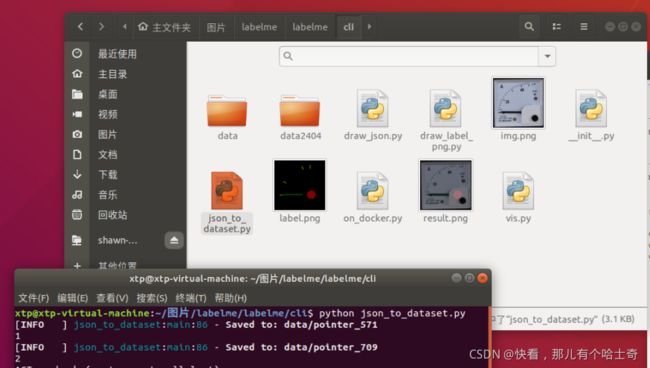图像分割 json文件 批量转mask
图像分割 json文件 批量转mask
在进行labelme进行标注后有大量json文件,如果做图像分割需要转为mask才能进入进行训练
1.下载labelme
去github上搜索labelme,用git clone 下载
2.修改json_to_dataset.py 文件路径:label/label/cil/json_to_dataset.py
import argparse
import base64
import json
import os
import os.path as osp
import imgviz
import PIL.Image
from labelme.logger import logger
from labelme import utils
def main(file, outfile):
logger.warning(
"This script is aimed to demonstrate how to convert the "
"JSON file to a single image dataset."
)
logger.warning(
"It won't handle multiple JSON files to generate a "
"real-use dataset."
)
parser = argparse.ArgumentParser()
parser.add_argument("--json_file", default=file)
parser.add_argument("-o", "--out", default=outfile)
args = parser.parse_args()
json_file = args.json_file
if args.out is None:
out_dir = osp.basename(json_file).replace(".", "_")
out_dir = osp.join(osp.dirname(json_file), out_dir)
else:
out_dir = args.out
if not osp.exists(out_dir):
os.mkdir(out_dir)
data = json.load(open(json_file))
imageData = data.get("imageData")
if not imageData:
imagePath = os.path.join(os.path.dirname(json_file), data["imagePath"].split("/")[-1])
with open(imagePath, "rb") as f:
imageData = f.read()
imageData = base64.b64encode(imageData).decode("utf-8")
img = utils.img_b64_to_arr(imageData)
label_name_to_value = {"_background_": 0}
for shape in sorted(data["shapes"], key=lambda x: x["label"]):
label_name = shape["label"]
if label_name in label_name_to_value:
label_value = label_name_to_value[label_name]
else:
label_value = len(label_name_to_value)
label_name_to_value[label_name] = label_value
lbl, _ = utils.shapes_to_label(
img.shape, data["shapes"], label_name_to_value
)
label_names = [None] * (max(label_name_to_value.values()) + 1)
for name, value in label_name_to_value.items():
label_names[value] = name
lbl_viz = imgviz.label2rgb(
label=lbl, img=imgviz.asgray(img), label_names=label_names, loc="rb"
)
PIL.Image.fromarray(img).save(osp.join(out_dir, "img.png"))
utils.lblsave(osp.join(out_dir, "label.png"), lbl)
PIL.Image.fromarray(lbl_viz).save(osp.join(out_dir, "label_viz.png"))
with open(osp.join(out_dir, "label_names.txt"), "w") as f:
for lbl_name in label_names:
f.write(lbl_name + "\n")
logger.info("Saved to: {}".format(out_dir))
if __name__ == "__main__":
import os
import os.path as osp
json_path = "../SR-line/" #json文件路径
out_path = "../SR-line_vis/" #输出mask保存文件路径
os.makedirs(out_path, exist_ok=True)
for file in os.listdir(json_path):
if ".json" in file:
main(osp.join(json_path, file), osp.join(out_path, file.split(".")[0]))
修改完后在json_to_dataset.py路径下运行:python json_to_dataset.py (第一次运行过程中缺什么包安装什么包:pip install [缺少的包] 即可)
备注:
1.mask是8bit,原图是24bit,需要正确的图片格式输入网络才能正确训练,否则模型无法正确学习
2.文件保存格式和路径可以适当修改json_to_dataset.py里面的代码
简单版:
"""
将用labelme分割打标工具打标获取的json文件批量转换为mask(annotation)图及对应图片
"""
# import argparse
import base64
import json
import os
import os.path as osp
import uuid
import imgviz
import PIL.Image
from labelme import utils
if __name__ == "__main__":
base_dir = osp.dirname(osp.abspath(__file__))
out_dir_name = "out_data"
out_dir = osp.join(base_dir, out_dir_name)
if not osp.exists(out_dir):
os.mkdir(out_dir)
label_names = []
label_file = "./label_names.txt"
label_value_dict = {}
with open(label_file) as f:
labels = f.readlines()
if len(labels) > 0:
for i, item in enumerate(labels):
item = item.strip()
label_value_dict[item] = i
json_file_name = "jsons" #'cityspaces'
json_file_path = osp.join(base_dir, json_file_name)
new_filename = 1
for file_name in os.listdir(json_file_path):
print(file_name)
if file_name.endswith(".json"):
filePath = osp.join(json_file_path, file_name)
data = json.load(open(filePath))
imageData = data.get("imageData")
if not imageData:
imagePath = os.path.join(os.path.dirname(filePath),
data["imagePath"])
with open(imagePath, "rb") as f:
imageData = f.read()
imageData = base64.b64encode(imageData).decode("utf-8")
img = utils.img_b64_to_arr(imageData)
for shape in sorted(data["shapes"], key=lambda x: x["label"]):
label_name = shape["label"]
if label_name not in label_value_dict:
label_value = len(label_value_dict)
label_value_dict[label_name] = label_value
lbl, _ = utils.shapes_to_label(img.shape, data["shapes"],
label_value_dict)
label_names = [None] * (max(label_value_dict.values()) + 1)
for name, value in label_value_dict.items():
label_names[value] = name
lbl_viz = imgviz.label2rgb(lbl,
imgviz.asgray(img),
label_names=label_names,
loc="rb")
#new_filename = uuid.uuid4().hex
PIL.Image.fromarray(img).save(
osp.join(out_dir,
str(new_filename) + "_img.png"))
utils.lblsave(
osp.join(out_dir,
str(new_filename) + "_label" + ".png"), lbl)
new_filename = new_filename + 1
#PIL.Image.fromarray(lbl_viz).save(
# osp.join(out_dir, new_filename + "_label_viz" + ".png"))
for name, value in label_value_dict.items():
label_names[value] = name
with open("./label_names.txt", "w") as f:
for lbl_name in label_names:
f.write(lbl_name + "\n")
#

